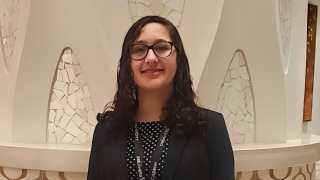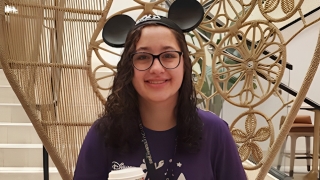Profound Bilateral Sensorineural Hearing Loss: Maria’s Story
Published on
Published on
Maria, 17, is a natural problem-solver. She loves to figure out math problems and fix electronics, so it only makes sense that she is part of her school’s robotics club. But her impressive feats don’t end there. Out of 10,000 applicants, she was among 100 students selected for the Disney Dreamers Academy, a four-day all-expenses paid event at Walt Disney World Resort. Not only that — she was even voted Dreamer of the Year by her peers for being impactful and inspiring others.
As she says in her Dreamers profile, Maria advocates for people who are deaf or hard of hearing and likes to promote deaf awareness in any way she can. She herself was diagnosed with profound bilateral sensorineural hearing loss at just 6 weeks old and has utilized bilateral cochlear implants since early childhood.
Her mom, Angela, recalls the day she and her husband, Giovanni, received the news and the initial devastation that accompanied it: “When we came home, we closed our curtains and turned off the phones and didn't want to talk to anybody. For two new parents, we honestly believed that was the end of the world.”
Until that point, no one in their extended family was deaf. As genetic testing would reveal, both of Maria's parents carried a gene for Connexin 26, the most common cause of genetic hearing loss in European and American populations. After the diagnosis, Maria started to utilize hearing aids, but due to the severity of her hearing loss, she began to plateau in her listening and spoken language skills.
By the time Maria was 2 years old, she and her younger brother, Francesco, had become candidates for cochlear implants, surgically implanted electronic devices that provide sound to a person who is profoundly deaf or severely hard of hearing. After much discussion, Angela and her husband, Giovanni, decided to have both siblings’ surgeries scheduled for the same day. Both Maria and Francesco were implanted by Ken Kazahaya, MD, medical director of the Hearing Implant Program at Children’s Hospital of Philadelphia (CHOP), using his minimally invasive surgical approach. They have since been under the care of CHOP audiologist Michael Jackson, AuD, who precisely programs their cochlear implants to ensure appropriate access to sound, which they rely on for hearing as well as spoken language communication.
With the cochlear implants (CIs), Maria can now hear more of the things she loves, whether music or people. “I can hear others good enough without having to gesture to them or trying to figure out these signals,” she says. “I'm able to talk to them.”
The CIs allow Maria to hear sounds she would have never expected, like the crunching of her hair when she brushed through a knot for the first time, just one of the many little things she has come to appreciate. Coupled with speech therapy from the Center for Childhood Communication at CHOP, the implants allow her to communicate via spoken language in addition to American Sign Language, whereas she had been almost nonverbal.
Now in her last year of high school, Maria is working harder than ever to prove to herself and others that “deaf people can do anything,” her favorite quote. She hopes to enter the STEM field and one day work with electronics as an engineer or Imagineer at Disney. 
“If I could tell my past self that everything would be fine, I would have reacted differently and probably would have gotten Maria implanted sooner,” shares her mom. “Now, I would tell new parents there's nothing to be afraid of. There's so much out there to help your kids. I'm happy that my kids have cochlear implants.”